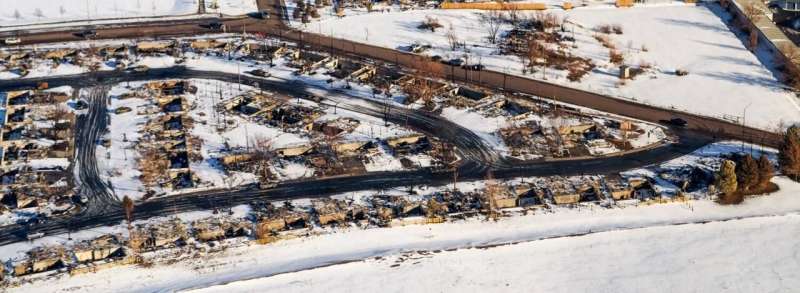This article has been reviewed according to Science X's editorial process and policies. Editors have highlighted the following attributes while ensuring the content's credibility:
fact-checked
peer-reviewed publication
trusted source
proofread
Soil toxic levels mostly minor after Marshall Fire in Boulder, Colorado

In the weeks following the devastating 2021 Marshall Fire, researchers from CU Boulder sifted through burned and unburned areas to test soils for toxic metals. Today, they report that although concentrations of toxic metals were somewhat higher on burned properties than unburned ones, those concentrations were lower than levels of concern for human health.
The results were published this month in Environmental Science & Technology.
"Given the extent and severity of the Marshall Fire, it is reassuring that soil contamination is not one of the problems residents or city officials need to worry about," said Sierra Jech, CU Boulder Ph.D. student and co-lead author of the study.
Wildfires in the Wildland Urban Interface (WUI) are becoming more frequent—raising concerns for policymakers, scientists, and residents. From 1990–2010, the number of homes in the WUI increased from nearly 31 million to about 43 million.
As homes pop up in wildfire-prone urban areas, the Marshall Fire might exemplify what's to come: Urban fires that burn homes and vehicles containing contaminants like copper, zinc, lead, chromium, and other toxic metals could enter soils and waterways, presenting new problems not seen in wildland fires.
A team from CU Boulder, led by CIRES Ph.D. students Sierra Jech and Cliff Adamchak with support from CIRES Fellows Eve-Lyn Hinckley and Noah Fierer, and researchers from Colorado State University worked together to answer two questions: Were soils on burned properties following the Marshall Fire more contaminated with toxic metals? If so, were these levels dangerous to human health?
"A lot of toxic materials were burned during the fire," Fierer said. "So people were justifiably worried that the soil in their backyards might be contaminated"
Three months after the fire, the team surveyed residents in affected areas and picked 58 properties for sampling. Half were burned, and half were outside the fire perimeter. Additionally, the team collected soils from nearby grasslands (burned and unburned) to assess the impacts of fire on wildlands without homes or cars.
Key findings from soil samples following analysis in the lab showed that soils on burned properties had measurably higher significantly higher concentrations of copper, zinc, lead, and chromium, which are typically considered toxic, than unburned properties. Metals were not elevated in the non-residential grasslands, highlighting the importance of anthropogenic material combustion (vehicles and homes) in post-fire soil contamination.
When the researchers analyzed levels of metals to determine if they were dangerous to human health, they found concentrations well below the estimated thresholds of concern determined by the EPA. The authors expected to find elevated levels of Polycyclic Aromatic Hydrocarbons (PAHs), a group of often toxic chemicals as observed following wildland fires, however PAHs were not elevated in soils following the urban Marshall Fire.
"Studies like this one are important to share broadly," said Hinckley, "because it would be very easy for residents to be fearful or concerned about soil contamination when rebuilding on their properties, in the absence of data."
More information: Sierra Jech et al, Determination of Soil Contamination at the Wildland-Urban Interface after the 2021 Marshall Fire in Colorado, USA, Environmental Science & Technology (2024). DOI: 10.1021/acs.est.3c08508
Journal information: Environmental Science & Technology
Provided by University of Colorado at Boulder




















